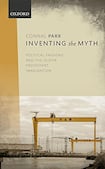
Writing in the Times of London in August 1985, the late Enoch Powell, then Unionist MP for South Down, and author of the notorious "Rivers of Blood" speech in 1968, dismissed a collection of essays, Across a Roaring Hill, edited by Edna Longley and the present writer in honour of Belfast poet and art curator, John Hewitt. The book was, Powell protested, one in a line of work "much petted and encouraged by those, in Great Britain and elsewhere, who want to bully the Northern Ireland electorate out of their settled conviction to remain within the United Kingdom". How a collection of literary essays, "exploring the Protestant imagination in Modern Ireland" (as the subtitle had it) could "bully" an entire "electorate" never failed to baffle me.
Thirty and more years later and here we are again, as historical landfall issues of frontiers and electorates’ wishes abound. This time, though, the idea of a “protestant” imagination is not quite so contentious as it was back in the 1980s post-hunger strikes when the Troubles were agonisingly tearing the heart out of civic society.
In Inventing the Myth: Political Passions and the Ulster Protestant Imagination, Connal Parr has produced a timely and scholarly monograph on (primarily) playwrights whose backgrounds are generally and deeply influenced by their Protestant upbringing in "Ulster", the Six Counties or Northern Ireland: Thomas Carnduff, St John Ervine, John Hewitt, Sam Thompson, Stewart Parker (both of whom died tragically in mid-career in their late 40s), Ron Hutchinson, Graham Reid, Gary Mitchell, Marie Jones and Christina Reid, who sadly died in 2015. Alongside the writing and beliefs of these writers Parr has interweaved a cultural history of theatre in both parts of the island in exploring the role of The Abbey Theatre, and its Peacock stage in providing a platform for northern Irish writers, Belfast's Lyric Theatre, and crucially the pioneering work of Charabanc Theatre Company, established in 1983, comprising "Marie Jones, Eleanor Methven, Carol Scanlon, Brenda Winter, and Maureen McAuley" and Pam Brighton who, according to Parr, was introduced to the group by Belfast playwright, Martin Lynch, a contemporary touchstone for this study.
But also, and critically, Parr identifies the left-leaning social democratic views (with historical links to Northern Ireland Labour Party) which many of the playwrights such as Sam Thompson (who stood in the general election of 1964 for NILP in the unlikely setting of South Down). It is this account which has, Parr suggests, been either kept out of the picture, patronised or simply derided: for northern Protestantism (as if it were all the one thing) read bigotry and sectarian bile.
If Parr has achieved nothing else in his fine study, correcting this sloppy self-serving cultural prejudice would be enough. But Inventing the Myth goes much further and, in its seven ample and thoroughly researched chapters drawing on extensive interviews he conducted and archive material, Parr has assembled irrefutable and substantiated proof that places the varieties of northern Protestantism within the radical traditions of an inherited British working-class socialism of solidarity and its inherited social democratic beliefs in the separation of church from state, educational opportunities for all irrespective of class or creed, and the protection of the welfare state as of right.
What is more, as Parr's necessary study reveals time and time again, many of his selected writers viewed Ireland, north and south, in much wider contexts of European political traditions. The tragedy, as we now know, is that these beliefs were not able to withstand the descent into political violence which characterised Northern society from the late 1960s until the late 1990s; a descent charted with great sympathy and dramatic irony in, for instance, Parker's Pentecost, set during the height of the unionist opposition to the Sunningale Agreement in 1974 but also reveals the significant personal bravery given the danger Gary Mitchell's plays brought to both himself and his family.
Although, again as Parr shows here, several of the writers he discusses, paid for their commitments to their democratic vision in lost opportunity and local opposition (for example, Hewitt); others found little in the emerging Irish Free State to recommend it.
St John Ervine’s view of the Northern premier, Lord Craigavon, of whom he wrote a biography, brought forth the ire of G B Shaw who queried how Ervine could spend time researching “that walking monument of obdurate mindlessness. Not even a reactionary, for reaction means movement and he was immovable”’.
This anatomy of northern literary culture brings into focus a society long since cut adrift from its industrial and social roots, something we are all being made aware of globally in a fashion unforeseen in the immediate years after the Good Friday Agreement was signed in 1998. In the 20 years since, as Parr reveals, the “deterioration” is not only in Protestant working class neighbourhoods and produces the statistic: “Northern Ireland’s highest levels of unemployment and deprivation are to be found in the Catholic areas of Whiterock, the Falls, and the New Lodge in Belfast”. And continues: “Forty-three per cent of children in West Belfast live in poverty against 21 per cent in East Belfast, while the highest levels of recorded crime are to be found – by far – in the same vicinities”. This is an appalling indictment of political leadership, making the current stand-off all the more inexplicable.
In exploring the social and political contexts of northern Irish Protestantism, its inheritance of dissent (what Dawn Purvis, former leader of the Progressive Unionist Party refers to as “independent thought”) and linking this history to the “literary imagination” and its “connection to the theatre”, Parr has opened the door on the history of creative self-questioning and critical debate that is all so often passed by.
Gerald Dawe’s “The Wrong Country: Selected Essays on Modern Irish Writing” will be published next year by Irish Academic Press. He taught for many years at Trinity College Dublin
















